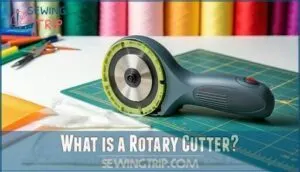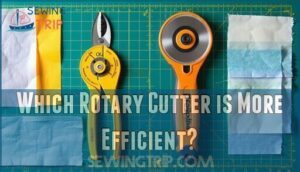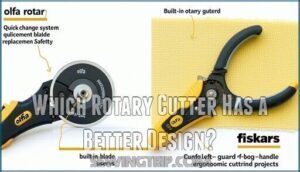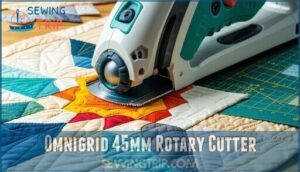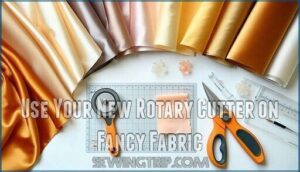This site is supported by our readers. We may earn a commission, at no cost to you, if you purchase through links.

Olfa cutters are known for their sharp, long-lasting blades and precise cuts, making them a favorite for quilting and intricate fabric projects.
On the other hand, Fiskars offers budget-friendly options with ergonomic handles that reduce hand strain, ideal for beginners or long crafting sessions.
While Olfa prioritizes durability and performance, Fiskars leans into comfort and affordability.
If you’re tackling heavy-duty projects, Olfa might be your go-to, but Fiskars shines for everyday crafting.
The real question is—do you value precision or comfort more? Your answer holds the key!
Table Of Contents
- Key Takeaways
- What is a Rotary Cutter?
- Which Rotary Cutter is Best for Me?
- Which Rotary Cutter is More Comfortable?
- Which Rotary Cutter is More Efficient?
- Which Rotary Cutter Has Better Quality?
- Which Rotary Cutter Has a Better Design?
- Which Rotary Cutter is More Cost Efficient?
- How to Use a Rotary Cutter?
- Choosing Your Rotary Cutter
- Use Your New Rotary Cutter on Fancy Fabric
- Frequently Asked Questions (FAQs)
- Conclusion
Key Takeaways
- Olfa cutters focus on sharp, long-lasting blades great for precision cuts, while Fiskars offers affordable options with ergonomic handles for comfort during long use.
- For heavy-duty or intricate tasks, Olfa excels with superior blade precision, but Fiskars is ideal for easy handling and multiple layers.
- You can use both brands interchangeably with 45mm compatible blades, but always check for slight fit variations to avoid alignment issues.
- Olfa cutters are pricier but durable, making them a great long-term investment, while Fiskars provides budget-friendly choices with solid performance.
What is a Rotary Cutter?
When tackling fabric projects, a rotary cutter is your best friend.
Think of it as a pizza cutter for fabric—only sharper and more precise.
With circular blades ranging from 18mm to 60mm, it slices cleanly through multiple fabric layers in one smooth motion.
Whether you’re quilting, sewing, or crafting, it’s a game-changer.
To use it, you’ll need a quality cutting mat to protect your table and help your blade last longer.
Brands like the Olfa rotary cutter and Fiskars rotary cutter offer models with excellent safety features, like blade guards, to keep your hands safe.
Always use caution—these blades are razor-sharp.
Rotary cutters work well on everything from cotton to leather, but different materials might require different cutting techniques.
For thicker materials, consider using a 60mm rotary blade for ideal cutting.
With the right sharpness, a reliable mat, and solid safety habits, this tool transforms your cutting tasks into quick and clean precision work.
Which Rotary Cutter is Best for Me?
Choosing the right rotary cutter depends on your project needs, comfort, and skill level.
Both Olfa and Fiskars offer high-quality options, each with unique features to suit different preferences and tasks.
OLFA Vs Fiskars
Deciding between an OLFA rotary cutter and a Fiskars rotary cutter boils down to your priorities.
OLFA shines with its sharper blade material, precise cuts, and a built-in blade guard for safety features.
Fiskars, however, offers ergonomic handle designs ideal for longer use and a quick blade change system.
While OLFA emphasizes durability and efficiency, Fiskars provides a broader blade range, suiting diverse projects.
Both boast strong brand reputations, so the best choice depends on your cutting needs and comfort preferences.
Which Size of Rotary Cutter Do I Need?
The right rotary cutter size depends on your project type, fabric thickness, and cutting curves.
Larger blades, like a 60mm, work great for thick materials or cutting straight lines quickly, while smaller blades, such as 28mm, excel at handling delicate fabrics and tight curves.
Your comfort also matters; choose a size that feels natural in your hand for better control.
Knowing the available cutter options can further refine your selection.
- 45mm Blade: A versatile option for most projects.
- 60mm Blade: Ideal for bulk cutting and heavy fabrics.
- 28mm Blade: Perfect for precision and curves.
- 18mm Blade: Best for fine, intricate details.
Which Rotary Cutter is More Comfortable?
Finding a comfortable rotary cutter is essential, especially for long crafting sessions.
Both the Olfa rotary cutter and Fiskars rotary cutter excel in ergonomic features but suit different needs.
- Grip Design: Olfa offers contoured handles and finger grooves, while Fiskars includes a curved, loop handle.
- Hand Fatigue: Fiskars’ lightweight build reduces wrist strain, ideal for extended cuts.
- User Preference: Olfa’s adjustable cutters for both hands are versatile, while Fiskars focuses on simplicity.
Ultimately, comfort depends on ergonomic preferences and project demands.
Which Rotary Cutter is More Efficient?
Efficiency is where the olfa rotary cutter and fiskars rotary cutter really shine, each bringing unique strengths to the table.
Cutting speed is essential for large fabric projects, and both brands deliver impressive results. OLFA offers a variety of blade sizes and sharpness levels, making it ideal for precise cuts on diverse fabric layers.
Fiskars, on the other hand, stands out with its titanium-coated blades that stay sharper longer and tackle multiple layers effortlessly. Both brands offer universal 45mm blades suitable for any cutter.
Here’s a quick comparison:
| Feature | OLFA | Fiskars |
|---|---|---|
| Blade Durability | Sharp but needs more changes | Longer-lasting titanium blades |
| Fabric Layer Capacity | Up to 4 layers | Works well on thicker stacks |
| Weight | Lightweight for detailed cuts | Heavier, sturdy for straight cuts |
Mat compatibility also plays a role in efficiency. Both cutters glide smoothly, but choosing the right one depends on your task’s suitability. Need precision or speed? Either way, these cutters transform tedious jobs into quick, satisfying tasks!
Which Rotary Cutter Has Better Quality?
In terms of blade sharpness, material durability, and cut accuracy, both the Olfa rotary cutter and Fiskars rotary cutter are strong competitors.
Olfa’s products stand out for their exceptional blade sharpness—independently tested to cut twice as long as standard blades. This means you’ll enjoy lasting performance even with detailed, repetitive cutting projects.
The premium materials used for their handles also guarantee consistent cut accuracy over time, making them a favorite for precision-based tasks.
On the other hand, Fiskars rotary cutters offer titanium-coated blades, which enhance durability and keep costs lower for replacement blades. This combination of sharpness and affordability makes them a smart choice for heavy-duty use.
Plus, their cutting mats are known for durability, prolonging blade life. Both brands also offer universal 45mm blades, which enhances their versatility.
Regarding priorities for sharpness or cost efficiency, this rotary cutter comparison highlights quality elements in both brands that meet diverse crafting needs.
Which Rotary Cutter Has a Better Design?
In the context of design, both the OLFA rotary cutter and the Fiskars rotary cutter show thoughtful craftsmanship that prioritizes comfort and efficiency.
Their ergonomic handles are standout features, ensuring a firm, strain-free grip for extended use. Whether you’re quilting or working on intricate cuts, these tools are thoughtfully designed for precision.
OLFA’s quick blade changing system makes replacing blades effortless, a huge win when you’re knee-deep in projects. The built-in blade guard adds an extra layer of safety, giving peace of mind during use.
On the other hand, Fiskars focuses on durability. Their handles are robust, made from high-quality materials, and offer excellent stability for smooth cuts.
Another notable difference lies in versatility—OLFA caters well to left-handed users with adjustable handle designs, while Fiskars excels in comfort-loop handles that reduce hand fatigue.
- Highlights of OLFA Design:
- Quick-change blade system for ease.
- Built-in, easy-to-lock blade guard.
- Left-handed friendly handle design.
- Smaller, ergonomic options for intricate cuts.
- Highlights of Fiskars Design:
- Durable handle materials.
- Comfort-loop handle to minimize fatigue.
- Stable, easy-control grip.
- Ideal for heavy-duty cutting projects.
Which Rotary Cutter is More Cost Efficient?
Comparing cost efficiency between the OLFA rotary cutter and the Fiskars rotary cutter comes down to balancing the initial cost, durability, and blade lifespan.
OLFA’s quick-change mechanism minimizes downtime, offering long-term savings despite higher replacement blade prices.
Meanwhile, Fiskars’ tungsten steel blades are exceptionally durable, boasting a longer lifespan at a lower upfront rotary cutter price.
Both deliver quality, but consider your priorities—OLFA for efficiency and ease, or Fiskars for affordability and cutter durability. The choice depends on your project’s demands!
How to Use a Rotary Cutter?
Using a rotary cutter might seem tricky at first, but it’s all about proper technique and safety.
Master the art of clean, precise cuts with steady pressure, the right tools, and safety-first habits every time you craft.
Whether you choose an OLFA or Fiskars cutter, the key is steady pressure and the right tools like a cutting mat for clean, precise results.
Top Tips
An accurate cut starts with proper tools and habits.
Always prioritize mat maintenance to protect blades and improve precision.
For safer and smoother blade changes, follow brand guides—OLFA is easier than Fiskars.
Safety first: retract blades after use.
Match your cutter to the fabric choice for clean results.
Consider specialized rotary cutter options for different tasks.
Mastering cutting technique guarantees a perfect slice, making any rotary cutter—OLFA or Fiskars—a versatile ally.
OLFA Deluxe 45mm Rotary Cutter
The OLFA Deluxe 45mm Rotary Cutter is a favorite for enthusiasts tackling detailed projects like quilting or sewing.
Its ergonomic grip keeps your hand comfortable, even during long sessions. This tool’s standout feature is its blade changes, designed for quick swaps without hassle or mess.
Whether you’re cutting through multiple layers or working on precise quilting applications, its cutting performance is smooth and accurate. Many users love its versatility with rotary cutter blades, making it a reliable choice for intricate designs.
If you’re debating between an OLFA rotary cutter and a Fiskars rotary cutter, this model deserves a closer look! For those interested, you can find a deluxe rotary cutter online.
Fiskars Titanium 60mm Rotary Cutter
The Fiskars Titanium 60mm Rotary Cutter blends titanium-coated blades with a comfortable ergonomic handle design, making it perfect for cutting multiple layers effortlessly.
Its durability stands out in any rotary cutter review, offering long-lasting sharpness for the best projects.
With an easy blade change system and precision, this Fiskars rotary cutter is your go-to tool for tackling fabric or crafting tasks.
OLFA 45mm Aqua Splash Rotary Cutter
Step up your crafting game with the OLFA 45mm Aqua Splash Rotary Cutter. Designed for precision and style, its ergonomic Aqua design guarantees comfort during long sessions.
Here’s what makes it a standout:
- Aqua Splash Features: Sleek, lightweight, and delightful to hold.
- Blade Change Ease: Swap blades effortlessly with safety intact.
- Cutting Mat Pairing: Works wonders on self-healing mats.
- Best Fabrics: Perfect for quilting cotton and other fine materials.
- Sharp Accuracy: Achieve clean, straight cuts every time.
Time to slice smarter!
Omnigrid 45mm Rotary Cutter
The Omnigrid 45mm rotary cutter offers impressive cutting performance, ideal for quilting applications.
It features a sharp blade compatible with standard rotary cutter blades, which guarantees precise cuts on fabric.
Its ergonomic design reduces hand strain, making long projects manageable, but it’s not as versatile as an Olfa rotary cutter or a Fiskars rotary cutter, making it a solid option for specific needs.
Choosing Your Rotary Cutter
Choosing the right rotary cutter depends on your project needs, budget, and preferences. Both the OLFA rotary cutter and Fiskars rotary cutter offer standout features.
Look for the right blade material and size—45mm suits most, while 60mm handles thicker fabrics. Prioritize handle design for comfort, especially during long tasks.
Compare safety features like blade guards or ergonomic grips. Finally, balance quality and budget options carefully, as prices vary widely.
Here’s a quick checklist:
- Blade size: 45mm or 60mm?
- Handle design for comfort.
- Blade material for durability.
- Safety features, like auto-retract.
- Budget options versus long-term value.
Use Your New Rotary Cutter on Fancy Fabric
Once you’ve chosen the best rotary cutter, it’s time to experiment with fancy fabrics and release your creativity.
To master silk cutting or handle velvet seamlessly, pair the right blade with precise tools like a cutting mat and ruler. For lightweight fabrics like chiffon or lace, a smaller blade—such as OLFA’s 28mm rotary cutter—offers more control.
For thicker materials, the larger 60mm blade size found in some Fiskars rotary cutters works wonders for clean, consistent cuts. Don’t forget satin techniques and lace precision, which depend on gentle handling and sharp blades.
Always retract the blade when it’s not in use to prevent accidents. Regular sharpening or blade replacement guarantees your tool stays reliable for fabric cutting tasks.
With OLFA or Fiskars, these fabric cutting tools allow you to turn delicate materials into dazzling designs.
Frequently Asked Questions (FAQs)
Are Olfa Rotary Cutters More Expensive Than Fiskars Cutters?
Yes, Olfa rotary cutters are generally more expensive than Fiskars.
However, Olfa offers exceptional blade sharpness and durability, making them a long-term investment.
Fiskars, while cheaper, focuses more on user-friendly designs and versatility.
Which Brand Offers Sharper Blades, Olfa or Fiskars?
Olfa blades are sharper and excel in precision cuts, making them perfect for detailed work like quilting or intricate sewing.
Fiskars blades, while sharp, focus more on durability and efficiency for heavy-duty or layered projects.
Which Brand is Better for Quilting, Olfa or Fiskars?
Picture yourself quilting vivid patterns; Olfa’s sharper blades suit intricate designs, while Fiskars’ ergonomic cutters reduce fatigue on large projects.
Both excel, but Olfa edges out for precision, and Fiskars shines for comfort.
Can You Interchange Blades Between Olfa and Fiskars Rotary Cutters?
You can interchange blades between Olfa and Fiskars rotary cutters if they share compatible sizes, like 45mm.
However, check the center hole design, as slight differences might cause fit or alignment issues during use.
How Long Will Each Rotary Cutter Last?
With proper care, rotary cutters can last decades.
Fiskars models are durable but may show wear sooner with heavy use, while Olfa cutters, known for long-lasting sharpness and build quality, often outlive their counterparts.
What Types of Fabric Can Each Rotary Cutter Be Used On?
You can use rotary cutters on cotton, denim, felt, fleece, and even delicate fabrics like silk or chiffon.
Both Olfa and Fiskars work well, but Olfa excels at precision cuts, while Fiskars handles heavier materials.
Are There Any Safety Features Built Into the Rotary Cutters?
Safety features like blade guards and locking mechanisms help prevent accidents.
Olfa cutters have a built-in blade guard, while Fiskars offers quick blade retraction.
Both are designed to minimize injuries and enhance secure handling.
Are There Any Special Cleaning or Maintenance Requirements for Each Rotary Cutter?
Keep your rotary cutter blades clean by wiping them with a soft, dry cloth regularly.
For OLFA, changing blades is simpler, while Fiskars’ quick-change system eases maintenance.
Both benefit from sharp blades and proper storage.
Are There Any Accessories Available for Each Rotary Cutter?
Rotary cutters come with add-ons like replacement blades, blade sharpeners, ergonomic grips, and storage cases.
You’ll also find specialty blades for pinking or scalloping, making cutting chores creative, efficient, and suited to your crafting needs.
Is Fiskars a good rotary cutter?
Fiskars rotary cutters are a solid choice, especially for beginners.
They’re durable, easy to handle, and offer ergonomic designs.
While not as sharp as Olfa, they’re reliable, versatile, and great for most crafting and sewing projects.
Conclusion
Studies show that a sharp rotary cutter can improve cutting efficiency by up to 30%, which highlights the importance of choosing the right one.
Whether you prioritize Olfa’s precision and durability or Fiskars’ comfort and affordability, the decision depends on your specific needs.
For intricate quilting, Olfa shines, while Fiskars is perfect for everyday crafting and beginners.
Ultimately, the "best" rotary cutter in the Olfa vs Fiskars debate comes down to your priorities—sharp precision or effortless comfort. Choose wisely!

